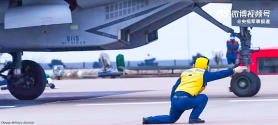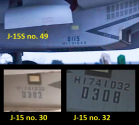What do we know about j-15s capabilities? Like its radar range, number of targets it can engage etc.
You can't realistically expect an answer to that kind of specific question.
What do we know about j-15s capabilities? Like its radar range, number of targets it can engage etc.
I don’t see how this is a good estimation on J-15 capabilities? Irbis-E is a Russian PESA radar where as J-15 uses a domestic planar array radar, it’s like comparing apples to oranges. Plus, it’s not like there are any deep technical connections (or at all) between the two radar models.Probably not.
But this may be a good estimation:
According NIIP's product specification, the Irbis-E can detect and track up to 30 airborne targets at one time at ranges near 350 kilometers, and attack up to 8. In air-to-surface mode the Irbis-E provides mapping allowing to attack four surface targets with precision-guided weapons while scanning the horizon searching for airborne threats that can be engaged using missiles. In air-to-surface mode, the radar has a limited .
It can detect a target with (RCS) 3m2 at up to 350 km within ± 120 degrees while the radar can get a quality track and engage four targets within 100 km range. In track-while-scan mode, the radar can engage two targets with semi-active radar homing missiles. It can detect and track up to 30 airborne targets with a Radar Cross Section (RCS) of three square meters at ranges of 400 kilometers using track-while-scan mode while engaging two targets with semi-active radar homing missiles or up to eight targets with active radar homing missiles. In the air-to-surface mode the Irbis provides clues allowing to attack two surface targets with precision-guided weapons while tracking up to four targets on the ground and scanning the horizon searching for airborne threats that can be engaged using active radar homing missiles.
Probably not.
But this may be a good estimation:
According NIIP's product specification, the Irbis-E can detect and track up to 30 airborne targets at one time at ranges near 350 kilometers, and attack up to 8. In air-to-surface mode the Irbis-E provides mapping allowing to attack four surface targets with precision-guided weapons while scanning the horizon searching for airborne threats that can be engaged using missiles. In air-to-surface mode, the radar has a limited .
It can detect a target with (RCS) 3m2 at up to 350 km within ± 120 degrees while the radar can get a quality track and engage four targets within 100 km range. In track-while-scan mode, the radar can engage two targets with semi-active radar homing missiles. It can detect and track up to 30 airborne targets with a Radar Cross Section (RCS) of three square meters at ranges of 400 kilometers using track-while-scan mode while engaging two targets with semi-active radar homing missiles or up to eight targets with active radar homing missiles. In the air-to-surface mode the Irbis provides clues allowing to attack two surface targets with precision-guided weapons while tracking up to four targets on the ground and scanning the horizon searching for airborne threats that can be engaged using active radar homing missiles.
This is public information. True characteristics of J-11B radar are classified. Still it gives an idea of numbers.But why mentioning a Russian radaon, when everybody knows, the regular J-15 uses the same radar like the J-11B?
This is public information. True characteristics of J-11B radar are classified. Still it gives an idea of numbers.
Alright, in that case be happy with Wikipedia.No, both are in no way comparable radars, so to ask, what performance maybe my Renault Scenic as a family car has and then present my neighbour‘s Audi A6 and what it can or not is more or less irrelevant.
Alright, in that case be happy with Wikipedia.
It can detect a target with (RCS) 3m2 at up to 350 km within ± 120 degrees while the radar can get a quality track and engage four targets within 100 km range.


